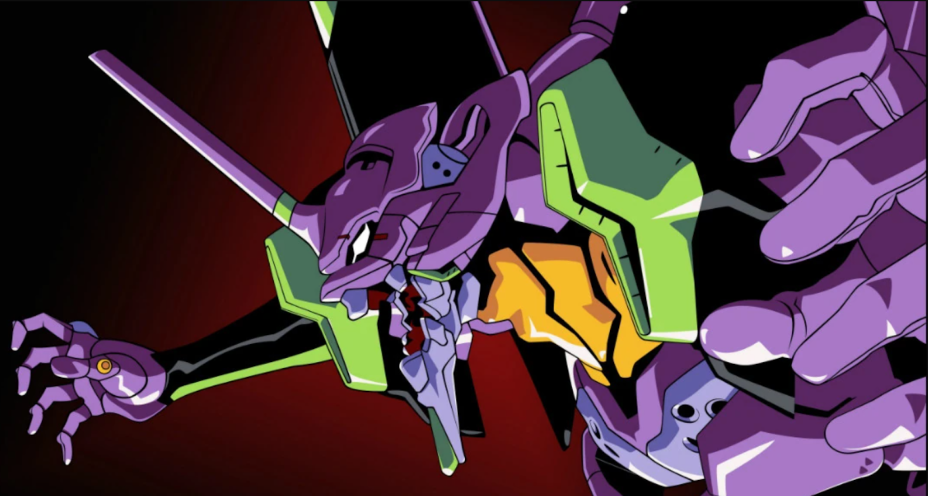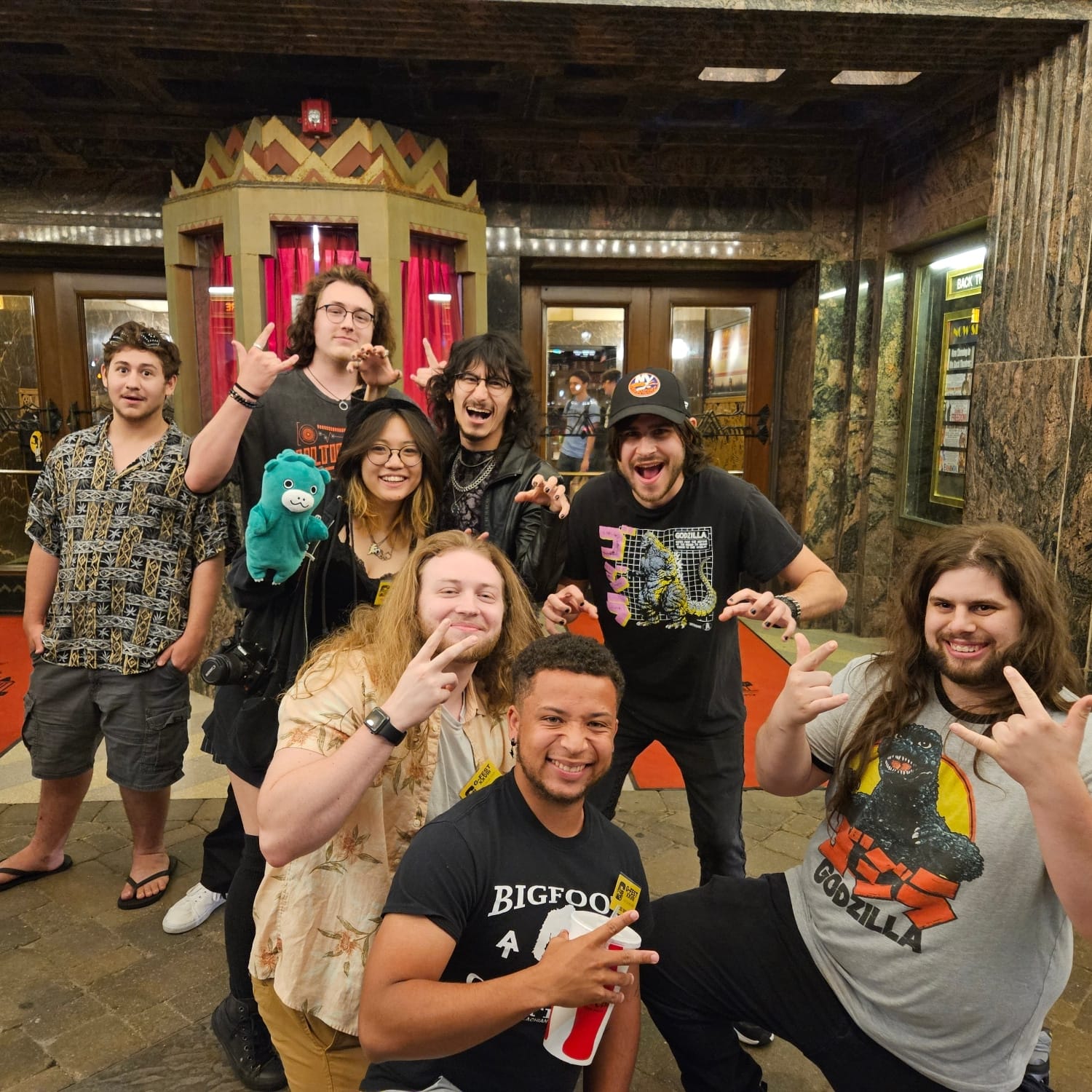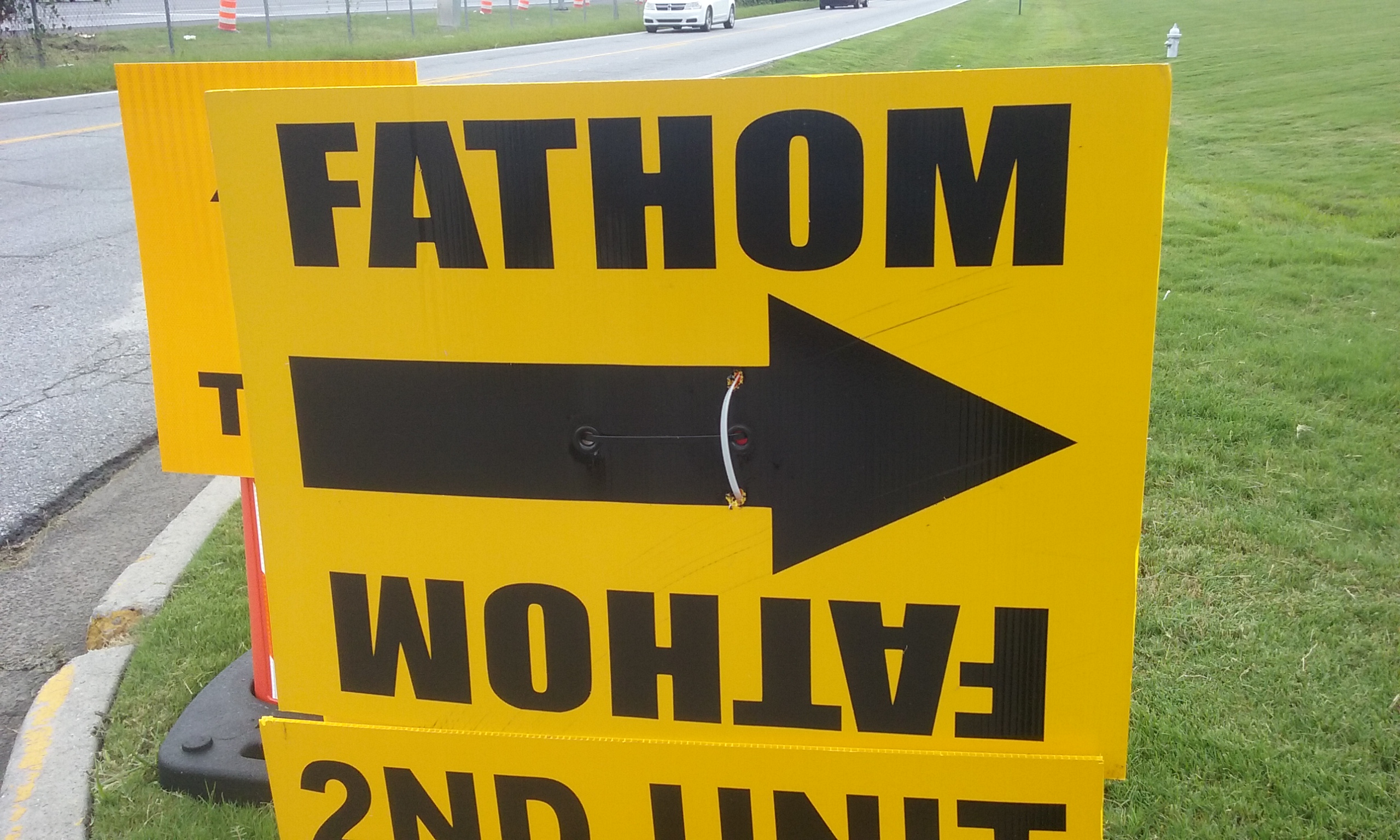Confession: I only recently watched the Evangelion franchise.
That would be the animated television series Neon Genesis Evangelion, the sequel film End of Evangelion (1997), and the four Rebuild of Evangelion films (2007-2021).
As you can probably infer by this, I am not an “Anime Guy”. I am, however, very much a “Tokusatsu Guy”. In the US, these fandoms can sometimes have surprisingly little overlap! I don’t know to what extent that’s true or not in Japan. But what I can infer is that over there, Evangelion Is Big. From amusement parks, to a pachinko empire, toys of every description, and highly publicized crossovers, the imagery of the franchise leaves a big footprint. But looming even larger is the resonance that the ideas of the franchise have had.
In fact, now that I have seen Evangelion, a great many elements of more-recent tokusatsu have snapped into focus for me. These elements make sense in their own right, of course, but they are suddenly clearer in the context of Evangelion. It’s like going back and reading Dune before revisiting the first Star Wars. Creative choices don’t happen in a vacuum, and creative people build on each others’ work.
This is about where I ought to summarize Evangelion for those folks who are unfamiliar, just like I had been. It is a work that is quite challenging TO summarize—it starts off very straightforwardly, then balloons exponentially in visual and thematic complexity. Suffice it to say that we begin with a seemingly ordinary schoolboy, Shinji, who is summoned to a seemingly ordinary city by his father just as it is attacked by a strange giant creature. His father’s subordinate brings him to a massive city-beneath-the-city, a tremendous complex called NERV, and he’s ordered to board an immense humanoid robot–EVA-01–to engage the creature–the Third Angel.

Shinji and EVA-01 are able to defeat the Angel despite the failure of conventional military forces, and Shinji settles into a routine in the next several episodes: go to school, get summoned to NERV, beat the Angel. Only certain children can operate the Evangelion machines. As the Angels continue to appear and NERV steps up its operations, Shinji meets and forms tempestuous emotional relationships with the mysterious and withdrawn Rei, who pilots EVA-00, and the outspoken and aggressive Asuka, who pilots EVA-02.
So far, so familiar!
Creator Hideaki Anno has admitted to Ultraman being one of his major inspirations for the work. However, the B-plot of mysterious government quasi-religious shenanigans eventually takes over from the Angel-fighting A-plots, much like how the various conspiracies of Twin Peaks overshadowed that show’s initial murder mystery. It’s gradually revealed that Earth itself is already in a post-apocalyptic state, and the people in charge of NERV have plans to reactivate the very same forces that depopulated it for an ultimate divine plan called the Human Instrumentality Project. Various characters are trying to manipulate this mysterious project to their own ends, and it’s due to happen one way or another once all of the Angels are destroyed.
Finally the series wraps up with the sequel film End of Evangelion and things get…weird. Abstract, mystic, psychosexual, fourth-wall-shattering-weird. Fans arguing about what stuff means for over 25 years weird. And on top of all that, the later Rebuild films at first appear to be remaking the original series, but then veer off into a completely different set of events, both dependent on and independent of the original. Despite the fact that there really isn’t that much of the Evangelion franchise, a deep dive is not for the faint of heart.
But that’s not what we’re here for. We’re here to explore the impact that the Evangelion franchise had on various high-profile kaiju-related projects. I think this sheds light on why certain decisions were made that are otherwise obscure, at least to us US fans of Japanese works.
DISCLAIMER: I am in every relevant way a NON-EXPERT on anime in general, Evangelion in particular, and on the specific mechanics of tokusatsu production! This is just my personal after-the-fact journey of mind-expanding realizations about various films that watching Evangelion led me to.
Gamera 2 and 3
Seeing the Heisei Gamera trilogy is a pretty decent litmus test for a hardcore kaiju fan. Even as I waited with bated breath for ADV Media to release these films on DVD in the early 2000s, I’d been swamped by gushing English-language reviews. The first film, Gamera: Guardian of the Universe, was the first to reach US shores on VHS. (My first exposure of any kind to Evangelion was through a trailer on this tape, since ADV also distributed Evangelion in the US.)
Now, for reference, Neon Genesis Evangelion began airing after Gamera 1 came out, and before 2 and 3.
Now, Gamera 2 is still mostly sci-fi…mostly. The opening scene with the government conspiracy was compared to The X-Files by US reviewers, but the paternalistic hostility of the unnamed agents also brings NERV vibes. Much more blatant is the introduction of a burning, unmistakably Christian cross in the title animation. In case you couldn’t guess from the title, Evangelion just LOVES trafficking in this imagery. The monster Legion has roots in many different sci-fi creatures, notably Giger’s Alien by way of Heinlein’s Bugs from Starship Troopers, but something about the utter oddness of the creature’s biology and its monolithic, unstoppable nature brings to mind the Angels as well.
But if we can question the influence of the Angels on Legion, there’s simply no debate when it comes to Iris. Gamera 3 presents a creature ostensibly from antiquity—a Phoenix rather than an Angel—but looking nothing like the popular conception of such a creature. Or, indeed, like any kind of creature. Like the Angels, Iris has bizarre sensory organs; hard lines and sharp angles where they aren’t expected; an abstract and technological appearance despite being fully organic; a penchant for using mysterious tentacles and fluids to mind-rape unfortunate young people; and a thoroughly inscrutable way of moving and behaving. Iris also brings to mind the Evangelions themselves, with its quasi-maternal desire to engulf and be directed by a child—and here we may note that a major theme of Evangelion is that Angels and Evas are not all that different. And if all this weren’t enough, Iris even sports the Evas’ distinctive shoulder fins! (Comparison image)
But the influence of Evangelion on Gamera 3 is not at all limited to Iris. The way that the hard sci-fi of the previous two entries melts into a fantasy framework for an impending apocalypse is very similar to how the series progresses. The film’s sharply-dressed “fortune-teller” directs the government just as Evangelion’s academic-mystics do. The rejection of clear exposition in favor of audience interpretation—leading to fierce debates on how to interpret the film, particularly its ending—also very characteristic of NGE. And in the end of both works, the audience is asked to have faith that despite all appearances, everything will be fine—to trust that the successful mental journey of the lead character should take priority above the threat of the physical world ending.
Let me put it this way. The major reason that I wanted to write this article is because after I finished End of Evangelion, a thunderbolt went off in my brain. “Oh, that is fully why Gamera 3 is Like That.” It’s not that Gamera 3 can’t be appreciated and understood in its own right—far from it! But the context for why the second sequel to a fairly straightforward monsters-on-the-loose movie is a religious conspiracy apocalypse thriller with a bonkers ending was, I would argue, created by the contemporary success of Neon Genesis Evangelion.
And as my final point on that front, I’ll observe that Shinji Higuchi—director of VFX for the Gamera trilogy, co-director of Shin Godzilla, and a writer and storyboard artist for NGE—was asked if he had any ideas for “Shin Gamera,” and he replied that it was “already done,” referring to that Heisei Gamera trilogy.
Godzilla Against Mechagodzilla and Godzilla Tokyo SOS:
Back before I had my context, I was quite bemused by a certain S.H MonsterArts toy—Kiryu in the colors of EVA-01.
Now that I’m enlightened, the parallels are quite clear, and the structure of the Kiryu duology only emphasizes them. Godzilla Against Mechagodzilla, like the beginning of Neon Genesis Evangelion, is pretty straightforward and focuses on the bond that is created between a vast humanoid machine and its pilot, supported by a vast military network. In sharp contrast to the other Mechagodzillas, Kiryu’s power requirements are a major element of the plot—reminiscent of the Evas’ reliance on a power cable and their 5-minute deadline if it is severed. In its very first adventure, Kiryu goes berserk—exactly like EVA-01. Kiryu’s defeat of Godzilla at the end of the film brings to mind the middle of NGE, when the kids and the Evas and NERV are really getting their act together to protect the city.
However, just as NGE does as it continues, Godzilla: Tokyo SOS starts yanking at the seams. An important—through heavily foreshadowed—reveal in NGE is that the Evas are not robots at all, but powered armor that controls an enslaved humanoid creature underneath. Similarly, we learn in Tokyo SOS that Kiryu is no mere “DNA computer” robot but is physically built around the remains of the original Godzilla. This foreshadows that Kiryu has its own sapience and its own agenda. Fortunately, Mothra is a far more benevolent god than any of the Angels, and Kiryu’s inevitable fall is not nearly so…momentous…as EVA-01’s.
Pacific Rim: Guillermo del Toro’s joyous 2013 mashup of all things kaiju and robot can’t help but shout-out to Evangelion, given its influence. The pilot suits look like nothing so much as the Eva franchise’s famous “plugsuits.” There’s a mysterious fluid that does something or other that is briefly seen in the first mounting sequence, visually reminiscent of NGE’s central substance/plot device “LCL.” The pilots are dramatically dropped into the Jaegers, something like how the pilot plugs are slammed into the Evas. Now, the dual-pilot system has no antecedent in Evangelion (at least not till the 2012 film You Can (Not) Redo, which came along a bit late to influence Pacific Rim), but it creates a similar problem of pilots being difficult to locate, and swapping pilots between machines being possible on only a very limited basis. (The fact that Jaeger pilots need to have a relationship with each other, even though it doesn’t have to be familial, DOES bring to mind a certain famous revelation about the Evangelions.)
Moreover, the Kaiju in the Pacific Rim universe do share some DNA, no pun intended, with the Angels. Both are bizarre organisms that have deep similarities despite appearing quite different on the outside. They also are seemingly-unthinking servants of a larger, ancient agenda to remake the earth, killing the humans who inhabit it in service of something very alien.
Shin Godzilla, Ultraman, Kamen Rider: Well, for anyone living under a rock, Evangelion creator Hideaki Anno directed Shin Godzilla! The works also share composer Shiro Sagisu, who re-purposed much of his music from the series. While I had yet to plunge into Evangelion when I first saw Shin Godzilla, the connections between the works were widely commented on from the start.
Shin Godzilla plays almost uncannily like the first episode of Neon Genesis Evangelion, only without the Eva. Godzilla shares the unnerving, inexpressive quality of the Angels, particularly its dull curiosity when munitions burst harmlessly on and around it. The American stealth bombers inadvertently causing a massive escalation from the enemy brings to mind several iconic sequences when NERV and the Evas get in over their heads. And the elaborate industrial plan to stop Godzilla, “Operation Yashiori,” is similar to several similarly grandiose efforts depicted in the show and the films, particularly the climax of the first Rebuild film, You Are (Not) Alone. Even Evangelion’s famous heroines are acknowledged here—while the connections of the brash, white-coded, late-arriving Asuka Langley Soryu and Kayoko Anne Patterson are more obvious, Rei Ayanami’s shadow also appears in the form of the reserved and awkward scientist Hiromi Ogashira.
Of course, all three Shin films are connected at the root to Evangelion, particularly the Rebuild films. For marketing purposes, the Shin films and the Rebuild films form the “Shin Japan Heroes Universe.” Since none of the events of the Shin films are compatible with the Rebuild timeline, it doesn’t mean anything “canonically,” but it does make possible monstrosities such as this:
Yes, that is a toy of EVA-01, Ultraman, and Godzilla smooshed together, with Kamen Rider for a head, wielding “AT Fields” from the Evangelion franchise like shields.
…anyway of all the films it’s perhaps Shin Kamen Rider with the closest thematic connections to Evangelion. The film’s final villain plots to merge all human thoughts into one mindscape, which is essentially Human Instrumentality. At the end of NGE, Shinji is betrayed by someone who he thought was a kindred spirit, leading to a clash between EVA-01 and EVA-02. Similarly, the film depicts a fierce battle between Kamen Rider 1 and Kamen Rider 2–which is not from the original Kamen Rider show. Then, in End of Evangelion, EVA-01 and EVA-02 find themselves opposing the Mass Production EVAs–just as the two Kamen Riders unite only to be opposed by an army of equivalent Riders. In both cases, the hero can only interfere with the villainous scheme by sacrificing his life and individuality as he knows it. Oh yeah, and a bunch of very icky body horror happens!
Gamera Rebirth: I could keep going–how the naval battle in Godzilla vs. Kong shouts out to the infamous episode 8 of NGE, how both of the Netflix Godzilla anime series are much more interested in high-concept sci-fi and philosophy–and weird time loops created by ancient conspiracies–than conventional kaiju wrestling. I could even observe that the odd naming scheme for the Rebuild movies immediately suggests why the latest Toho Godzilla film was marketed as “-1.0.”


But it makes sense to end where we began, with Gamera, and how the six-episode “summer” of Gamera Rebirth recapitulates the original arc of NGE and End of Evangelion. Though as we begin, the four protagonists feel much more like they’re from Stand by Me–a Stephen King adaptation that was a cult hit film in Japan as well as the US. After several adolescent misadventures featuring bullying and revenge-pranks, they end up narrowly surviving a pack of hunting Gyaos, only to barrel straight into a scene out of the first episode of NGE–literally underfoot of a huge monster.
Naturally, our viewpoint characters are pulled into the government agency that already exists to deal with these monsters–shades of NERV. But even well into the middle of Gamera Rebirth, the similarities seem superficial and largely structural. Even if it occurred to you that the female and male agents who work with the children have shades of NGE’s Misato and Ryoji, respectively, it’s on a pretty superficial level.
But then the series takes a hard turn into a set of NGE-like reveals. Rather than being random occurrences, the Kaiju are deeply related to each other just as the Angels are. They are also directly related to the heroic Gamera: similar to how the Angels were connected to the Evas. Almost exactly like NERV, the society that the kids discover is not just a special agency that liaises with the military, but an ancient cult with a frightening amount of control over world governments. This dovetails with the revelation that the kids’ involvement in events was not happenstance; they are genetically primed for their role and that meeting their deaths at the hands of a Kaiju could result in the unmaking of the world.
But Gamera Rebirth puts some playful twists into the formula just as it emerges. NGE’s Misato may have her own agenda, but she loves Shinji and the other children fiercely; Rebirth’s Emiko emerges as a vile woman, whose constant warm smile masks a chilling psychopath. NGE’s Ryoji affects a disinterested, too-cool-for-school attitude in order to hide his deep concern for the fate of the world and of the children; Rebirth’s Tazaki truly is that cynic at first, only to be redeemed by the children.
Fittingly, it is Gamera himself who ensures that Gamera Rebirth is about one wild and frightening summer rather than the apocalypse. At the end of the series, the true villains watch their scheme unfold from what they believe is safety on the Moon. Their role in events and their demeanor is essentially identical to the SEELE organization in Evangelion. Just like SEELE, they have accepted that the execution of their plan requires their lives to end.
>
In Evangelion, some version of Human Instrumentality does come to pass, thanks to SEELE’s manipulations, and EVA-01 plays a key, unwitting role. It’s only the will of Shinji that salvages some way for human life to continue–depending on audience interpretation, of course. But in Rebirth, the conspiracy only believes that they control Gamera. In fact, the Friend To All Children sacrifices himself to destroy his erstwhile masters. In effect, the grim fate of the Earth in all versions of the Evangelion story is teased, and then averted…at least, for now. (Season 2 when, Netflix?)
With that, our guided tour through the universe of post-Evangelion kaiju films and shows has ended! I hope that I’ve at least presented you with some interesting facts and perspective, whether or not you agree with my analysis.





